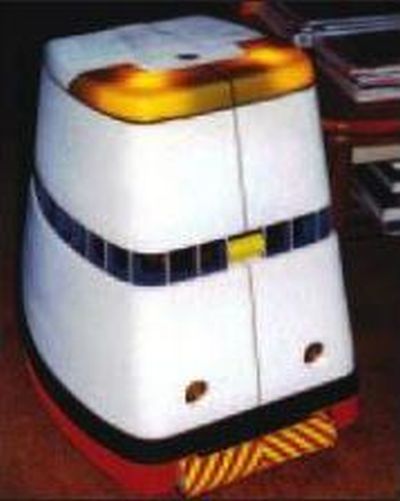
Extract from article by Tom Carroll, Servo Magazine, Nov 2006.
The above picture shows a robot vacuum cleaner that was a work of art, though a bit tall to clean under most furniture. Frank Jenkins of the Robotics Society of California demonstrated his home vac for our group 15 years ago. At 23 inches high and 44 pounds, HomeR was a bit larger than today’s machines, but contained over 80 sensors. It used an Ampro 386SX board computer with four megabytes of memory. It also had a Black and Decker hand vacuum system built in for the sweeping function and could find its way back to a charging dock. This beautiful machine may not have been able to snake its way under a low coffee table, but it was one of the most stunningly built that I had ever seen.
In an article appearing in Discover magazine (March 1993:28), Gregory T. Pope reveals Homer Hoover, the innovation of Frank Jenkins a computer programmer in Menlo Park, California.
"Homer will navigate with 12 ultrasonic sonar units and 24 light-level sensors. The sonars bounce inaudible sound pulses off the surroundings and gauge distances to objects by clocking the echoes of the pulses. The light-level sensors act in unison as a crude panoramic camera. In addition, built-in odometers will tell Homer have far it's rolled, and four extra sonars, along with infrared sensors, will spot nearby obstacles" (Pope).
Homer Hoover no longer requires that a human being be there to operate it. The vacuum cleaner will ultimately be able to vacuum the house and plug itself back in all through computer programming. Jenkins hopes also to build in a feature so that if Homer Hoover accidentally picked up a sock or the family cat, it would spit it out and vacuum around it. While Jenkins admits it would be at least another couple of years before his product would be ready for marketing, Pope reveals that the Japanese companies Matsushita and Sanyo have also begun to develop these robot vacuum cleaners.
While at first Homer Hoover might appear to be the ultimate technology in the household that would replace the worker, a deeper look would reveal the many limitations of Homer Hoover. First, unless the robot could climb stairs (even Rosie couldn't do that), Homer would only be practical in a single level house. Secondly, Homer would only be able to vacuum the floor, leaving such things as upholstery and drapery to be done by a human. Finally the cost of Homer and the potential cost of repair to Homer would be much more than the average two-income household could afford.
Frank Jenkins wrote a paper on Vacuum-cleaner robot design considerations titled "Practical Requirements for a Domestic Vacuum-Cleaning Robot". Here are the dimensions of HomeR from that article.
See other early remote-controlled and robotic vacuum cleaners and floor scrubbers here.